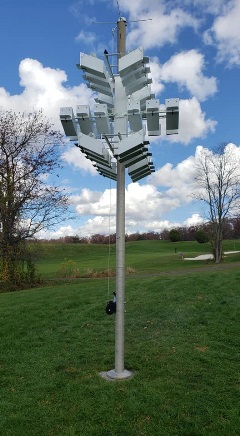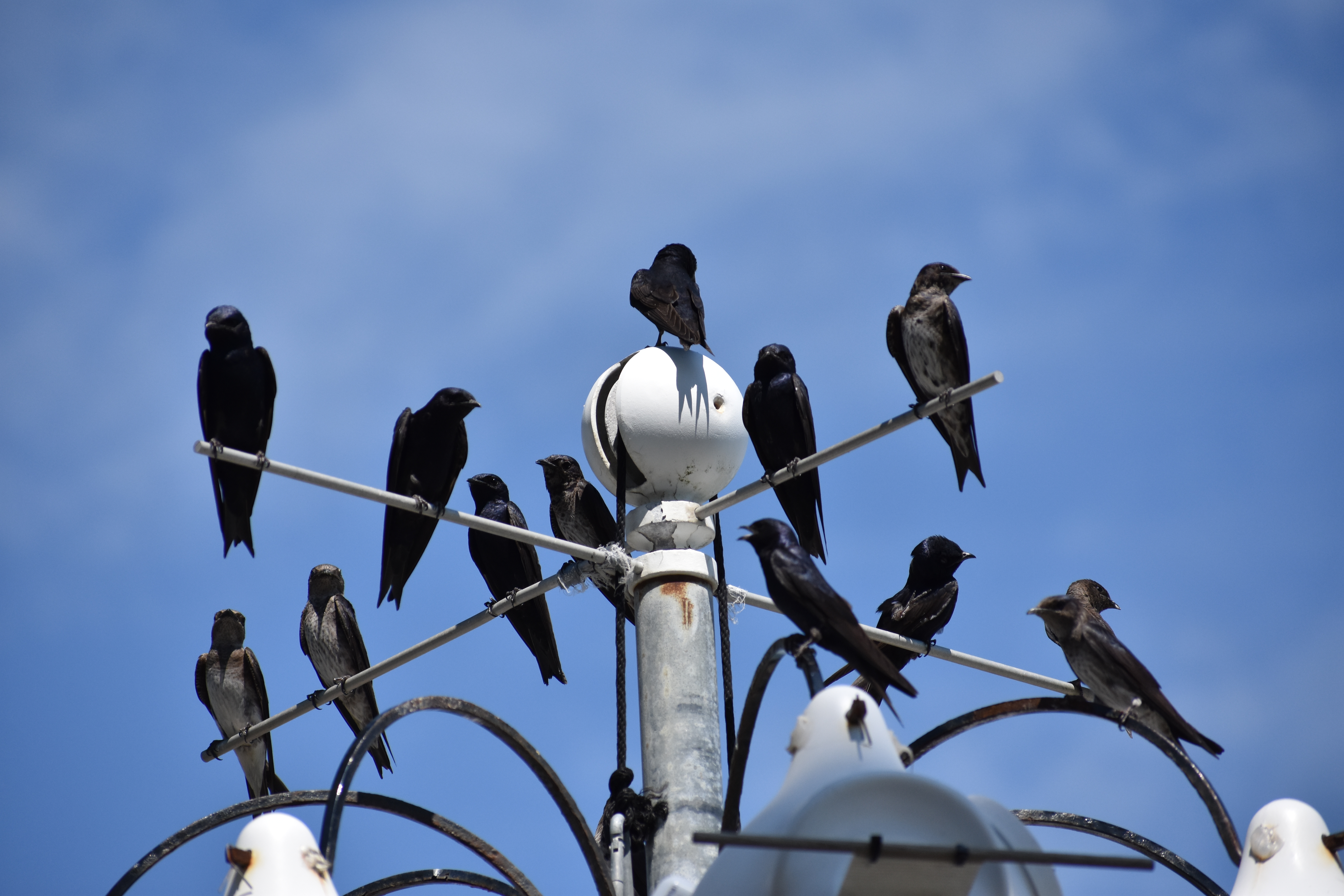In the 1950s, a bird enthusiast and TV antenna manufacturer in Griggsville, Illinois, came up with the idea of building and selling houses for purple martins (Progne subis). J.L. Wade promoted his all-aluminum bird houses by marketing the purple martin as America’s favorite bird – because it consumed thousands of mosquitoes every day.
While Wade wildly overstated the bird’s mosquito consumption, the advertising campaign worked. Weary of bites from the annoying insect, Americans bought and erected thousands of Wade’s bird houses.
Because purple martins prefer to nest together in colonies, the Wade-style bird houses look like little hotels. In yards and farms in virtually every state east of the Mississippi, you can still find many of Wade’s green and white houses for the purple martin.
Unfortunately, many of those structures are now unusable and have long since been abandoned by the birds.
A History with Humans
The close relationship between people and purple martins began long before Wade. During some of the first encounters between European settlers and Native Americans, the settlers observed gourds with small holes mounted on tall poles around the villages. The indigenous people had developed a semi-domesticated relationship with the purple martins. The birds would drive away crows, hawks and other species that pecked at drying animal hides, making the hides less useful.
The idea caught on among the Europeans, perhaps inspired by the fact that the martins do in fact dine almost exclusively on flying insects.
 Purple martin tower.Historically, the Eastern purple martin nested in natural cavities, like dead trees or “snags,” which provide essential habitat for a wide array of species. But the Europeans brought with them intensive logging for building and for fuel, and they introduced two invasive bird species – the European starling and the house sparrow – that would outcompete martins for nesting habitat.
Purple martin tower.Historically, the Eastern purple martin nested in natural cavities, like dead trees or “snags,” which provide essential habitat for a wide array of species. But the Europeans brought with them intensive logging for building and for fuel, and they introduced two invasive bird species – the European starling and the house sparrow – that would outcompete martins for nesting habitat.
Because of this competition and loss of habitat for nesting sites, the Eastern purple martin has adopted a preference for human-erected housing, which is unique among songbirds. Some of the genetically distinct Western purple martins (Progne subis arboricola) still nest in snags or saguaro cacti. Their population, west of the Rocky Mountains, is also fragile and benefits from citizen scientists who take an interest in hosting colonies.
As the “fad” of martin housing faded and loss of suitable habitat continued, the purple martin population fell by about one percent per year between 1966 and 2015, resulting in a cumulative decline of 37 percent, according to the North American Breeding Bird Survey.
Growing Need to Help a Falling Population
Fortunately, many people began to recognize the plight of the bird and became interested again in serving as “landlords” for the martins. With new and better housing options, thousands of colonies have sprung up across the U.S. and Canada in recent years.
As a member of the Arlington-Fairfax Chapter of the Izaak Walton League in Virginia and a naturalist for Fairfax County, I have an outsized interest in the fate of the purple martin.
A few years ago, I began a program to bring the martins back to the heavily populated and developed region. My martin journey began in the early 1980s when I installed bluebird and martin houses on my parent’s property in rural Spotsylvania County, Virginia. For almost 25 years, three colonies grew and thrived.
But in 2010, the property was sold and I no longer had access to the houses. At that time I was working at a large high school with a lot of open ground and received permission to put up a martin house there, although I had never seen that species in the area. But within two years, the house was filled with the birds. This inspired the idea of putting up more houses in the county’s schools and parks.
 Martins gather at the top of a colony in Virginia.
Martins gather at the top of a colony in Virginia.
Despite 1.2 million people living in Fairfax County and highly urbanized sections, the open spaces of parks and golf courses provided perfect habitat for these birds, who don’t mind being close to human activities. County officials I contacted totally supported the proposal and I recruited a few others to help. By 2015, I gave this work a name – the Northern Virginia Purple Martin Initiative – and began selecting sites to install colonies. By the end of the second year, 13 colonies were installed, and while most had just a few birds, some were already filled to capacity.
Now the Initiative maintains 25 active colonies at parks, golf courses, a university and a monastery. Together, the colonies have more than 350 individual nesting gourds and housing compartments. The average occupancy was 95 percent for the 2021 season, which equates to approximately 1,500 young purple martins fledged this year.
At the Arlington-Fairfax Izaak Walton League Chapter, one of my first conservation projects was setting up a martin colony. The open grounds combined with a nearby pond provide perfect habitat.
Because they live in colonies, the martins provide endless interest for the careful observer. As insectivores, the martins winter in South America. When spring arrives, the martins return and begin their cycle of fledging new generations, thanks to essential help from concerned conservationists.
How to Get Started
If you are interested in becoming a martin landlord, the Purple Martin Conservation Association has a wonderful website with useful information on martins and establishing a colony. The website includes a list of local or regional mentors who are glad to answer questions.
Purple martin colonies require maintenance to ensure they remain clean for every nesting season. The gourds are plastic and have a cleaning port. The steel or aluminum poles have racks that hold multiple individual gourds. The racks are affixed to a cable and pulley to raise and lower the gourds with a winch, which makes it easy to clean and maintain them. The gourds have an entry hole designed to allow martins but prevent starlings from nesting – usually a crescent-shaped hole rather than a round hole typically found on bird houses.
Setting up and maintaining a purple martin colony offers a rewarding conservation project for Izaak Walton League chapters, schools, Scouts or master naturalist programs.
Editor's Note: A Unique Challenge for Citizen Science and Local Conservation
The fate of the purple martin plainly rests in the hands of a small number of humans, mostly volunteers. Without younger volunteers who take on this stewardship role and are trained to build and maintain purple martin colonies, the bird could disappear. This is an apt metaphor for our larger challenge of preserving wildlife and habitat for posterity.
– Michael Reinemer
This article was excerpted from “Outdoor America” 2021 issue #4. Want more articles like this? Join the League and get four issues of our award-winning magazine every year.
Join the Izaak Walton League
Mike Bishop is an Izaak Walton League member at the Arlington-Fairfax Chapter and naturalist for Fairfax County, Virginia.